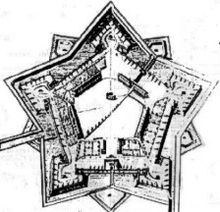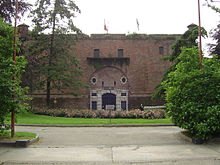Turin Citadel
The Citadel of Turin was a fortress in the shape of a regular pentagon within the urban area of Turin , the capital of Piedmont in Italy . It played a role in the siege of Turin in the War of the Spanish Succession in 1706.
history
The foundation stone for the citadel was laid in 1564, but construction was not completed until 1577. The construction work was led by the architect Francesco Paciotto , who had the area around the Church of the Holy Martyrs demolished for the construction project. The citadel was expanded before the siege and survived the demolition of the city walls around 1800.
In 1815, Jakob Lenk von Wolfsberg was a captain in the Imperial and Royal Army in the course of the Napoleonic Wars in Piedmont and received from the King the Sardinian Knightly Order of Saints for the exemplary handover of the citadel, after he had brought all movable war equipment there to safety. Mauritius and Lazarus.
The Carbonari attacked in 1821. During the 18th century, the citadel was used as a simple barracks. Demolition was decided in 1856, since only the mastio that still exists today , the former entrance building, which is used as an artillery museum, and the underground mines belonging to the Museo Pietro Micca have escaped.
investment
The citadel was built on the southwest side of the city where the San Pietro bastion was previously located. It had a wide, waterless trench. In the middle of the fortress was a large cistern , a well with a spindle-shaped double ramp and an underground defensive system.
Individual evidence
- ↑ Dr. Constant von Wurzbach, Biographisches Lexikon des Kaiserthums Österreich, Verlag der kk Hof- und Staatsdruckerei, Vienna, 1865, 14th part, pp. 361–363
Web links
- Extensive bibliography on the subject on the website of the city of Turin (it.) ( Memento from August 30, 2012 in the Internet Archive )
Coordinates: 45 ° 4 ′ 16 ″ N , 7 ° 40 ′ 28 ″ E

